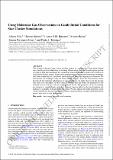Files in this item
Using molecular gas observations to guide initial conditions for star cluster simulations
Item metadata
| dc.contributor.author | Sills, Alison | |
| dc.contributor.author | Rieder, Steven | |
| dc.contributor.author | Buckner, Anne S M | |
| dc.contributor.author | Hacar, Alvaro | |
| dc.contributor.author | Zwart, Simon Portegies | |
| dc.contributor.author | Teixeira, Paula S | |
| dc.date.accessioned | 2023-01-09T17:30:01Z | |
| dc.date.available | 2023-01-09T17:30:01Z | |
| dc.date.issued | 2023-03-01 | |
| dc.identifier | 282829728 | |
| dc.identifier | a60d018e-a951-4c45-bea2-80fa3180e888 | |
| dc.identifier | 85171863538 | |
| dc.identifier.citation | Sills , A , Rieder , S , Buckner , A S M , Hacar , A , Zwart , S P & Teixeira , P S 2023 , ' Using molecular gas observations to guide initial conditions for star cluster simulations ' , Monthly Notices of the Royal Astronomical Society , vol. 519 , no. 3 , stac3745 , pp. 4142-4151 . https://doi.org/10.1093/mnras/stac3745 | en |
| dc.identifier.issn | 0035-8711 | |
| dc.identifier.other | Bibtex: 10.1093/mnras/stac3745 | |
| dc.identifier.other | ORCID: /0000-0002-3665-5784/work/132214029 | |
| dc.identifier.uri | https://hdl.handle.net/10023/26725 | |
| dc.description | Funding: AS is supported by the Natural Sciences and Engineering Research Council of Canada. SR acknowledges funding from STFC Consolidated Grant ST/R000395/1 and the European Research Council Horizon 2020 research and innovation programme (Grant No. 833925, project STAREX). AB is funded by the European Research Council H2020-EU.1.1 ICYBOB project (Grant No. 818940). This project has received funding from the European Research Council (ERC) under the European Union’s Horizon 2020 research and innovation programme (Grant agreement No. 851435). | en |
| dc.description.abstract | The earliest evolution of star clusters involves a phase of co-existence of both newly-formed stars, and the gas from which they are forming. Observations of the gas in such regions provide a wealth of data that can inform the simulations which are needed to follow the evolution of such objects forward in time. We present a method for transforming the observed gas properties into initial conditions for simulations that include gas, stars, and ongoing star formation. We demonstrate our technique using the Orion Nebula Cluster. Since the observations cannot provide all the necessary information for our simulations, we make choices for the missing data and assess the impact of those choices. We find that the results are insensitive to the adopted choices of the gas velocity in the plane of the sky. The properties of the surrounding gas cloud (e.g. overall density and size), however, have an effect on the star formation rate and pace of assembly of the resultant star cluster. We also analyze the stellar properties of the cluster and find that the stars become more tightly clustered and in a stronger radial distribution even as new stars form in the filament. | |
| dc.format.extent | 10 | |
| dc.format.extent | 7460547 | |
| dc.language.iso | eng | |
| dc.relation.ispartof | Monthly Notices of the Royal Astronomical Society | en |
| dc.subject | Star clusters: general | en |
| dc.subject | Star formation | en |
| dc.subject | QB Astronomy | en |
| dc.subject | QC Physics | en |
| dc.subject | DAS | en |
| dc.subject | MCC | en |
| dc.subject.lcc | QB | en |
| dc.subject.lcc | QC | en |
| dc.title | Using molecular gas observations to guide initial conditions for star cluster simulations | en |
| dc.type | Journal article | en |
| dc.contributor.institution | University of St Andrews. School of Physics and Astronomy | en |
| dc.identifier.doi | https://doi.org/10.1093/mnras/stac3745 | |
| dc.description.status | Peer reviewed | en |
This item appears in the following Collection(s)
Items in the St Andrews Research Repository are protected by copyright, with all rights reserved, unless otherwise indicated.

